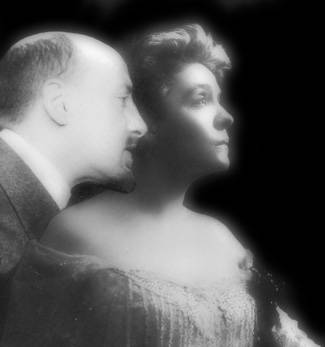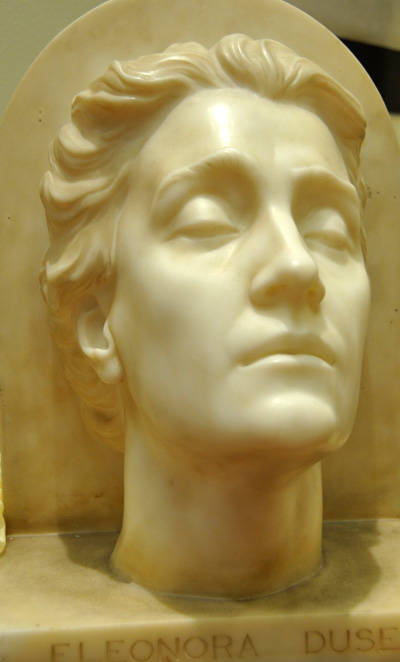The Secret Life of Gabriele D'Annunzio: a New Exhibit at NYU's Casa Italiana
@font-face {
font-family: "Cambria";
}p.MsoNormal, li.MsoNormal, div.MsoNormal { margin: 0in 0in 0.0001pt; font-size: 12pt; font-family: "Times New Roman"; }div.Section1 { page: Section1; }Father of modern Italian poetry, conquistador of celebrity culture, the original “Latin Lover”, decorated war hero and inspired revolutionary are just a few of the titles attributed to the poet Gabriele d’Annunzio at the world premier of “Gabriele D’Annunzio: Living Life as a Work of Art” at New York University’s Casa Italiana Zerilli-Marimò. The exclusive showing features artifacts from the poet’s estate, an impressive complex on the shores of Lake Garda, grandiloquently named, The Vittoriale for the Italian People. The exhibit will be on view at Casa Italiana through December 15th.
The wonderfully varied opening program, arranged by Casa Italiana director Stefano Albertini, included a dramatic reading of D’Annunzio’s poems in both Italian and English and a screening of the world’s first blockbuster movie, Cabiria. Short lectures were given by Giordano Bruno Guerri, President and Director of The Vittoriale, Paolo Valesio, Giuseppe Ungaretti Professor of Italian Literature at Columbia University and Angela Dalle Vacche, Professor of Literature, Communication and Culture at the Georgia Institute of Technology.
Prof. Albertini credits Anna Maria Andreoli, former president of The Vittoriale, with the idea for bringing the show to New York.
The exhibit artfully traces D’Annunzio’s life from his birth in Pescara, through his literary schooling in Prato and marriage into Roman society, to his military heroism as a pilot in WWI and the zealous conquest of Fiume (now Rijeka) in 1919, and finally to the establishment of his country estate, The Vittoriale, in Gardone Riviera. Along the way, we meet the many illustrious female artists who shared his extravagant desires and his bed. A marble bust of D’Annunzio’s most famous companion, the actress Eleonora Duse, greets viewers in the Casa Italiana lobby. Her ethereal gaze matches that of the many early photographs reproduced for the show in her honor. Those interested in the history of fashion and design will find a treasure trove in an impressive display of the great dandy’s clothing, shoes and accessories. Accoutrements from his table, including ornaments by the sculptor Renato Brozzi, line the minor gallery, along with the poet’s beloved equestrian gear and model airplanes.
The traveling exhibit, whose next stops include Athens and Tokyo, is among several new initiatives under the leadership of The Vittoriale’s current director, Giordano Bruno Guerri. A well-known contemporary Italian historian and T.V. personality, Guerri envisions a D’Annunzio “revival” worthy of the great poet’s contributions to the modern era. In his introduction, he emphasized the need to divest D’Annunzio of the common associations with fascism and decadence which have relegated him to relative intellectual oblivion.
Guerri’s many diverting anecdotes describe a man who was leaps and bounds ahead of his time, a trend-setter capable of publishing a bestseller at 16, making the suntan fashionable, “bombing” Vienna with leaflets, instructing Mussolini on public speaking and of single-handedly conquering a city on the Italian- Yugoslav border. D’Annuzio’s avant-garde exploration of language in poetry and prose, Prof. Valesio tells us, laid the groundwork for Ungaretti and Montale. Meanwhile Prof. Dalle Vacche reveals his gender-bending preferences for flowing garments and women in pants. Having understood the commercial value of celebrity before anyone else in his era, D’Annunzio’s fame was such that when director Giovanni Pastrone wanted to sell his first film, he contacted the poet. The film reached theaters with D’Annunzio’s billing and it quickly became an international sensation.
Born in March of 1863, D’Annuzio died in March of 1938. Historical circumstances effectively placed him between two worlds and perhaps, this serves to explain the many contradictions in his character. He was a passionate conservationist: he invented the term “cultural goods” (“beni culturali”) and the notion that these should be protected by a ministry of the State. And yet, no artist or writer embraced the turning of the 19th Century and the dramatic onslaught of modernity with quite the same vigor and energy. D’Annunzio was interested in science and technology, in sexuality and freedom, in women and fashion, in architecture, gardens and airplanes, ships and military offences, poetry and Nietzsche. He wanted to be a Prince and yet he founded a Republic in which women could vote and hold elected office almost 30 years before those rights would be recognized in Italy. He cultivated a monastic life-style and yet he continued to write, love and collect things with unyielding frenzy. He lived for luxury but insisted on the essential simplicity of beauty.
It was this assembling of the past and future in his person and in his artistic activities which made him a harbinger of modern Italian poetry. In Valesio’s words, D’Annunzio marshaled the literary monuments of the past and spent his career chipping away at the perfection of his assemblage.
Likewise, the exhibit is a rare opportunity to experience the novelty and the enthusiasm of early 20th Century modernism. D’Annunzio, his projects, and his things, embody the spirit of an age of excitement and innovation which was all but destroyed by the second world war.



































i-Italy
Facebook
Google+
This work may not be reproduced, in whole or in part, without prior written permission.
Questo lavoro non può essere riprodotto, in tutto o in parte, senza permesso scritto.